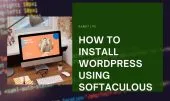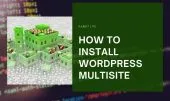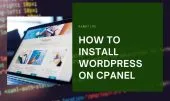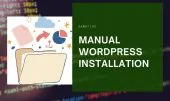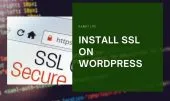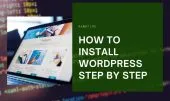- 1. Why You Should Install WordPress Locally
- 1.1. A Safe Testing Ground
- 1.2. Faster Performance and Development
- 1.3. Zero Downtime and Full Control
- 1.4. What You’ll Need
- 2. How to Install WordPress Locally – Step-by-Step
- 2.1. Step 1 – Choose a Local Server Environment
- 2.1.1. XAMPP
- 2.1.2. LocalWP (formerly Local by Flywheel)
- 2.1.3. MAMP
- 2.2. Step 2 – Download WordPress
- 2.3. Step 3 – Create a Database
- 2.3.1. Using XAMPP or MAMP
- 2.4. Step 4 – Configure WordPress
- 2.5. Step 5 – Set Up Your WordPress Admin Account
- 3. How to Access Your Local WordPress Site
- 4. Troubleshooting Common Issues
- 5. Best Practices for WordPress Local Development Environment
- 5.1. Keep Everything Organized
- 5.2. Regularly Back Up Your Local Projects
- 5.3. Use the Same PHP and MySQL Versions as Your Hosting
- 5.4. Experiment with Plugins and Themes
- 5.5. Export and Move to Live Server
- 6. Frequently Asked Questions
- 6.1. Is installing WordPress locally free?
- 6.2. Can I make my local site public?
- 6.3. Can I install multiple local WordPress sites?
- 6.4. Does WordPress local installation affect SEO?
- 7. Conclusion
Setting up WordPress locally on your own computer is one of the smartest ways to build, test, and experiment without affecting a live website. In this guide, you’ll learn how to install WordPress locally step by step — from choosing your local server to creating your first WordPress site in a safe, private environment.
Whether you’re a beginner, a developer, or a content creator, this complete tutorial will help you master the process of creating a local WordPress setup that mirrors a real hosting server. Let’s get started.
Why You Should Install WordPress Locally
If you’re new to web development or simply want a place to experiment, installing WordPress locally offers several advantages.
A Safe Testing Ground
A local WordPress environment lets you try new themes, plugins, and updates without any risk. Unlike a live website where one wrong move could break your site, the local setup is private — visible only to you.
You can test custom code, tweak CSS, and even rebuild entire pages without affecting users or search rankings. Once everything works perfectly, you can deploy it to your live server with confidence.
Faster Performance and Development
Working on a local server means no internet delays or upload limits. All files are stored on your machine, so pages load instantly. You can make changes and refresh the page immediately — perfect for quick debugging and theme customization.
For developers, a WordPress local development environment drastically reduces build time. For content creators, it means smoother workflow — write, preview, and style posts offline before publishing.
Zero Downtime and Full Control
Unlike editing a live website, working locally ensures zero downtime. Your visitors will never see “maintenance mode” pages while you test. You also have complete control over your environment — you can install or remove PHP versions, databases, or caching systems freely.
Whether you’re preparing for a new website launch or rebuilding an existing one, a local WordPress setup gives you peace of mind and professional flexibility.
What You’ll Need
Before you begin, make sure your computer meets these basic requirements:
- Minimum 4 GB RAM (8 GB recommended)
- At least 2 GB of free disk space
- Stable operating system: Windows, macOS, or Linux
- Internet connection (for downloading tools)
Once you’re ready, we’ll move on to the actual installation process.
How to Install WordPress Locally – Step-by-Step
This section will walk you through every step of the process — from choosing your local server software to setting up WordPress and accessing your new dashboard.
Step 1 – Choose a Local Server Environment
Before you install WordPress locally, you’ll need a local server environment that mimics real web hosting. It includes software like Apache or Nginx (for serving web pages), MySQL (for databases), and PHP (for running WordPress).
Here are the most popular and beginner-friendly tools:
XAMPP
Platforms: Windows, macOS, Linux
Overview: XAMPP is one of the most widely used tools for local development. It packages Apache, MySQL (MariaDB), PHP, and Perl into one easy installer.
Installation Steps:
- Visit apachefriends.org
- Download the version compatible with your OS.
- Run the installer and select Apache and MySQL.
- Start both services in the XAMPP Control Panel.
Once both modules turn green, your local server is live.
LocalWP (formerly Local by Flywheel)
Platforms: Windows, macOS
Overview: LocalWP is a beginner-friendly tool made specifically for WordPress. It automatically installs WordPress and sets up everything you need without manual configuration.
Installation Steps:
- Go to localwp.com
- Download and install the app.
- Open it and click “Create a New Site.”
- Choose your preferred PHP version and MySQL settings.
- Click “Start Site” — and you’re done!
You’ll have a working local WordPress installation in minutes.
MAMP
Platforms: macOS, Windows
Overview: MAMP is another lightweight local server ideal for macOS users (though it works on Windows too). It’s stable, simple, and great for testing small projects.
Installation Steps:
- Download MAMP from mamp.info.
- Install and open the MAMP app.
- Click “Start Servers.”
- Visit http://localhost:8888/ in your browser to confirm it’s running.
Once your local server is ready, it’s time to set up WordPress itself.
Step 2 – Download WordPress
Go to the official website: wordpress.org/download.
Click Download WordPress to get the latest version (a .zip file).
Extract the downloaded zip file into your local server’s root directory:
- XAMPP:
C:\xampp\htdocs\ - MAMP:
Applications/MAMP/htdocs/ - LocalWP: it handles this automatically.
Rename the extracted folder to your project name, such as my-local-site.
Step 3 – Create a Database
Every WordPress site needs a database to store content, settings, and user data.
Using XAMPP or MAMP
- Open your browser and visit http://localhost/phpmyadmin/
- Click Databases in the top menu.
- Enter a database name (e.g., wordpress_local)
- Click Create.
That’s it — your empty database is ready.
root), and password (leave blank by default) — you’ll need them in the next step.Step 4 – Configure WordPress
Open your browser and go to http://localhost/my-local-site/ — or replace my-local-site with the name of the folder you created earlier.
You’ll now see the WordPress installation wizard on your screen.
- Choose your language → then click Continue to move to the next step.
- Enter your database information exactly as follows:
- Database Name:
wordpress_local - Username:
root - Password: (leave this field empty)
- Database Host:
localhost
- Database Name:
Once you’ve filled in all the fields, click Submit, then select Run the Installation to start setting up WordPress on your local server.
Step 5 – Set Up Your WordPress Admin Account
Next, you’ll create your site information:
- Site Title: My Local WordPress Site
- Username: admin
- Password: create a secure one
- Email Address: your email
Click Install WordPress. Within a few seconds, WordPress will confirm that installation is complete.
Click Log In, enter your username and password — welcome to your local WordPress dashboard!
How to Access Your Local WordPress Site
You can open your local WordPress site anytime by visiting:
- Frontend: http://localhost/my-local-site/
- Dashboard: http://localhost/my-local-site/wp-admin/
From here, you can install themes, add plugins, or write blog posts just like on a live website.
Troubleshooting Common Issues
Even manual installations may face minor issues. Here are the most common problems and solutions:
- Database connection error: Verify credentials in
wp-config.php. - White screen of death: Check if all WordPress files were uploaded correctly.
- Login issues: Reset your password via phpMyAdmin.
- Slow performance: Use caching plugins like WP Super Cache or W3 Total Cache.
Best Practices for WordPress Local Development Environment
A local site is powerful, but using it efficiently requires a few smart habits. Regular backups, organized folders, and consistent testing will help you maintain stability, speed, and confidence before deploying changes live.
Keep Everything Organized
Create separate folders for each project. Example:
C:\xampp\htdocs\project1
C:\xampp\htdocs\project2
Name your databases accordingly (project1_db, project2_db) so you don’t mix up files or settings later.
Regularly Back Up Your Local Projects
Even though it’s local, data loss can happen due to system crashes or accidental deletions. Always back up your htdocs folder and database export.
Use the Same PHP and MySQL Versions as Your Hosting
To ensure smooth deployment later, match your local server’s PHP version with your hosting environment. This avoids compatibility issues with plugins and themes.
Experiment with Plugins and Themes
Your WordPress local setup is the perfect place to test new plugins or develop custom themes safely.
If you’re a developer, consider setting up version control with Git — this helps track changes and collaborate with others.
Export and Move to Live Server
When your local project is ready for the world, you can migrate it to your live hosting.
Tools like Duplicator, UpdraftPlus, or WP Migrate DB make it easy to copy your site and database to your web host.
Frequently Asked Questions
The following section answers the most common questions about installing and using WordPress locally. Whether you’re troubleshooting setup issues or exploring advanced configurations, these quick FAQs will help you find clear, practical solutions.
Is installing WordPress locally free?
Yes. Both WordPress and local server tools like XAMPP, LocalWP, and MAMP are completely free. You can build, test, and manage unlimited local sites without paying any hosting fees.
Can I make my local site public?
Not directly. Local installations are private by default. To share your site online, you must migrate it to a live hosting provider or use tools that enable temporary online sharing.
Can I install multiple local WordPress sites?
Absolutely. You can create multiple local sites as your computer allows. Just organize each project in a separate folder and assign a unique database name to avoid conflicts.
Does WordPress local installation affect SEO?
No. Local sites are not indexed by search engines. Since they exist only on your computer, any testing, content changes, or theme experiments won’t impact your live site’s SEO rankings.
Conclusion
Installing WordPress locally is the best way to learn, build, and test without risk. You can try new ideas, design websites offline, or develop plugins — all within a controlled, private space.
Once you master your local WordPress development environment, moving your project online will feel effortless.
So now that you know how to install WordPress locally, it’s time to open your tools and start building.
Whether it’s your first blog or your next big project — everything great starts right here, on your computer.
Ready to go live faster?
When your local site is ready for the world, choose a fast-loading WordPress theme like Rabbit Lite — lightweight, customizable, and built for performance. Perfect for both beginners and professionals.


